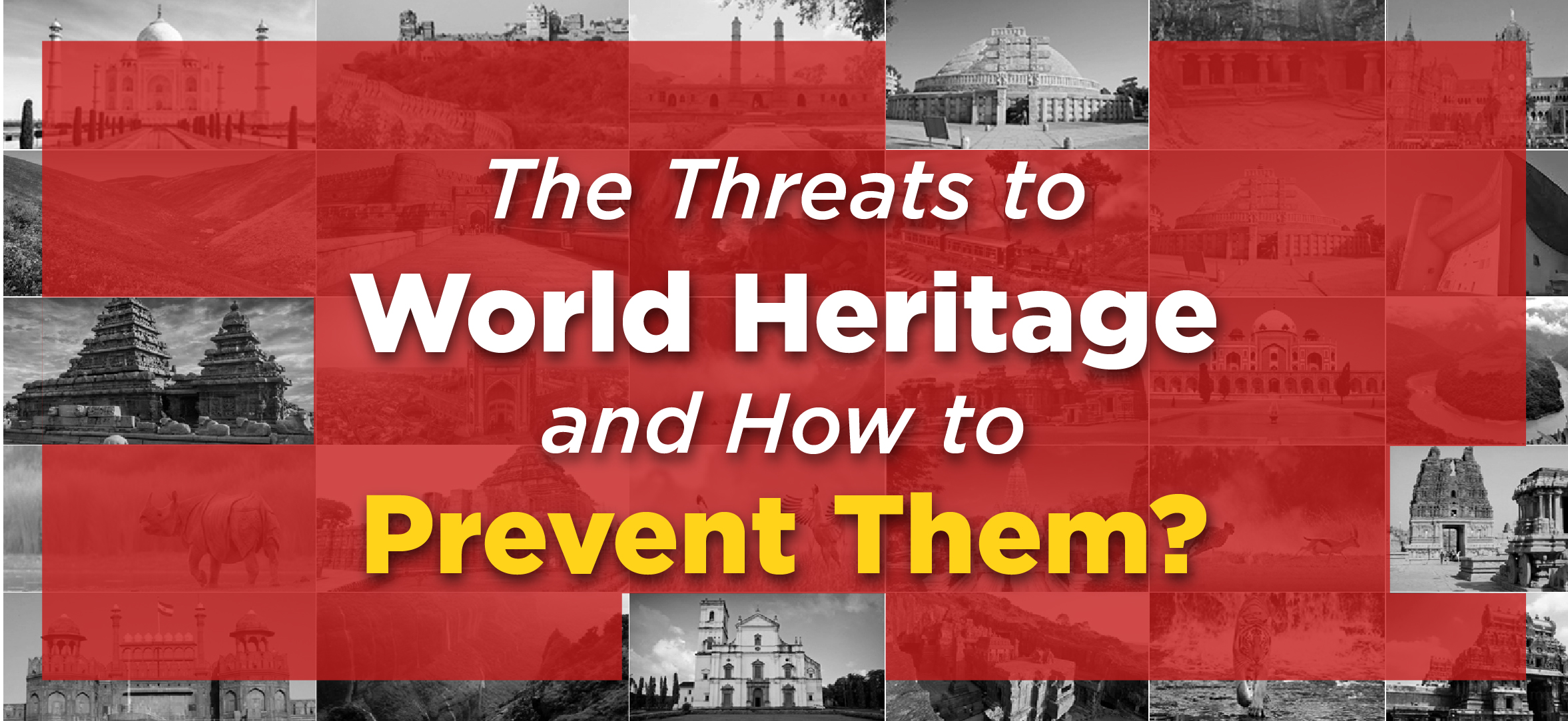The Threats to World Heritage and How to Prevent Them?
Blogs Home
- 18 Apr 2023

We celebrate World Heritage Day on the 18th of April also known as the International Day for Monuments and Sites. The purpose of the day is to celebrate the organizations that fight to protect human heritage and preserve it. UNESCO (United Nations Educational, Scientific, and Cultural Organization) first observed the day in 1983 intending to increase awareness of global diversity and cultural heritage. There is a total of 1,157 World Heritage Sites of which 900 are cultural, 218 natural, and 39 are mixed sites extending over 167 nations as of January 2023. The world benefits from having monuments, ethnicity, art and craft, historical structures, and natural heritage. World Heritage Sites serve as a source of essential resources like food, fuel, and water, as well as environmental services like constructing soils, preventing floods, and capturing carbon. They also significantly boost economies by creating jobs, promoting tourism, providing recreational opportunities, and exporting goods. Around 11 million people are living in the world who depend on heritage sites for food, water, medicine, and employment. But the poor environmental conditions, climate change, mass tourism, and inadequate management and resources are the major challenges that World Heritage Sites are facing today.
Major Threats to World Heritage
According to Article 11.4 of the World Heritage Convention, which was created in 1972 to identify and administer World Heritage Sites, UNESCO compiles the List of World Heritage in Danger. There are 55 sites that the World Heritage Committee has chosen to list that are considered to be at risk of extinction under this Article of the Convention. The World Heritage Sites on the list which comprises cultural, natural, and mixed sites are in danger and need extensive efforts to preserve them; aid has also been asked for. The list aims to promote preventative measures and raise global awareness of the concerns. A site may be threatened by actual dangers that are imminent or by potential threats that could harm the site.
Threats to Natural Heritage
Development plans, armed conflicts, inadequate management systems, or changes in the properties' legal protection status are all potential threats to both natural and cultural sites. The impact of planned infrastructure on the Natural World Heritage is also getting worse. The massive developments, such as the construction of highways, dams, tourist attractions, mining, and petroleum and natural gas projects, are one of the most serious potential threats. A severe decrease in the inhabitants of an endangered or other valuable species, as well as the degradation of a property's natural beauty or scientific value brought on by human activities like deforestation, pollution, and agricultural activities, are also very important examples of ascertained dangers in the case of natural sites.
With so many sites being seriously threatened, climate change is the hazard to World’s Natural Heritage that is increasing the fastest. Glaciers and coral reefs are two of the most severely impacted ecosystems. Climate change influences up to 85% of the reefs that had been assessed. The largest reef on Earth, the Great Barrier Reef, has experienced extensive bleaching as a result of the rise in the sea surface temperature of the world.
Threats to Cultural Heritage
Major issues for World Heritage Sites include violent warfare and conflict, earthquakes as well as other natural calamities, pollution, trafficking, unchecked urbanization, and uncontrolled tourist development. Threats can be "conclusively proven," which refers to particular, established risks that are immediate, or "probable," which refers to threats that potentially have a damaging effect on the values of World Heritage. It is crucial to keep in mind that a conflict or a serious environmental disaster can also have an impact on a person's right to exercise their culture. The dangers mostly concern tangible cultural heritage, such as buildings, collections in museums and libraries, and archives.
It is simply correct that cultural heritage is at risk of being destroyed, stolen from, or trafficked illegally in many parts of the world. It's also true that during the past few decades, new kinds of challenges to cultural heritage have emerged.
Climate change, urbanization, extractive industries, natural disasters, and even tourism have all caused far more damage than war between countries.
The losses of historical fact or cultural relevance are two risks identified for cultural properties, in addition to serious deterioration of the materials, structure, embellishments, or architectural coherence. Cultural sites may be at risk from gradual changes brought on by geology, climate, or the environment.
A greater number of sites will probably experience effects shortly because climate change is undoubtedly the greatest possible threat to the World Heritage. The combination of increasing threats and inadequate management and protection for World Heritage Sites is alarming. Natural as well as cultural heritage sites' distinctive characteristics could be irreparably lost or harmed if they are not adequately maintained.
Preventive Measures
Many of the World Heritage Sites contain several cultural heritage criteria, from significant architectural and artistic heritage to majestic natural beauty. These priceless locations serve as multifaceted and direct connections to our past and ought to be protected at all costs. Although it may seem difficult to preserve significant natural, cultural, and historic assets, there are many things that individuals and groups can do to assist. The 5 Cs given by the World Heritage Convention of UNESCO, are credibility, conservation, capacity building, communication, and communities.
Investing in the administration and conservation of World Heritage is essential to shield them from increasing threats. Authorities, civil society, local communities, and indigenous peoples all share a responsibility for this. National as well as global conservation efforts should first concentrate on these sites, which needs to be carefully monitored to determine which ones are most in danger of extinction. The world's most important protected places, World Heritage Sites, demand the highest caliber management for these to have a bright future. By collaborating with commercial partners, governments, regulators, civil society, and other important stakeholders on pertinent topics, we can increase public awareness of World Heritage Sites and encourage or support widespread action to safeguard these sites.
A property's condition is evaluated by the world heritage committee before listing it on the List of World Heritage in danger and a potential program for repair actions is devised in collaboration with the State Party concerned. The committee makes the ultimate determination regarding inscription. The committee has the authority to provide listed properties with money from the Fund of World Heritage. Every year, the committee reviews the condition of conservation and decides whether to ask for additional steps, remove the property from the list if the dangers have subsided, or consider removing it from both the World Heritage List and the List of World Heritage in Danger.
We must also pay attention to waste reduction, tree plantation, water saving, energy conservation, avoiding single-use plastics, divesting from fossil fuels, volunteering, composting, and not forgetting about the micro-plastics hidden in everyday household and personal care products.
Sources
https://whc.unesco.org/archive/opguide08-en.pdf
https://www.iucn.org/resources/issues-brief/natural-world
-heritage#:~:text=To%20protect%20sites%20from%20threats,site%20management%20can%20also%20help
https://www.unepfi.org/psi/wp-content/uploads/2018/06/Protecting-our-world-heritage.pdf
Arifa Nadeem

Arifa Nadeem is from Jhansi, UP. She has qualified UGC NET in Tourism Administration & Management and is currently pursuing her Ph.D. in Tourism from Bundelkhand University, Jhansi.
Blogs Home



